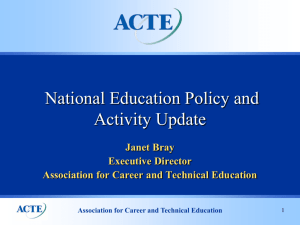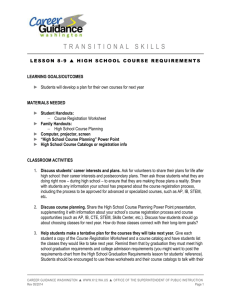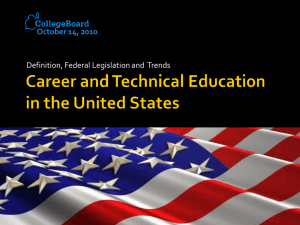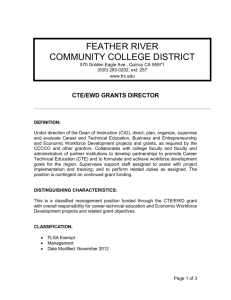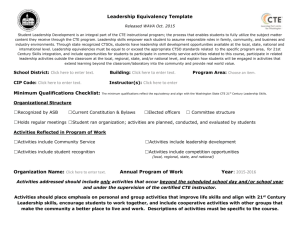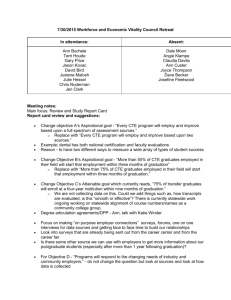February 2010 Winter Conference Power Point
advertisement
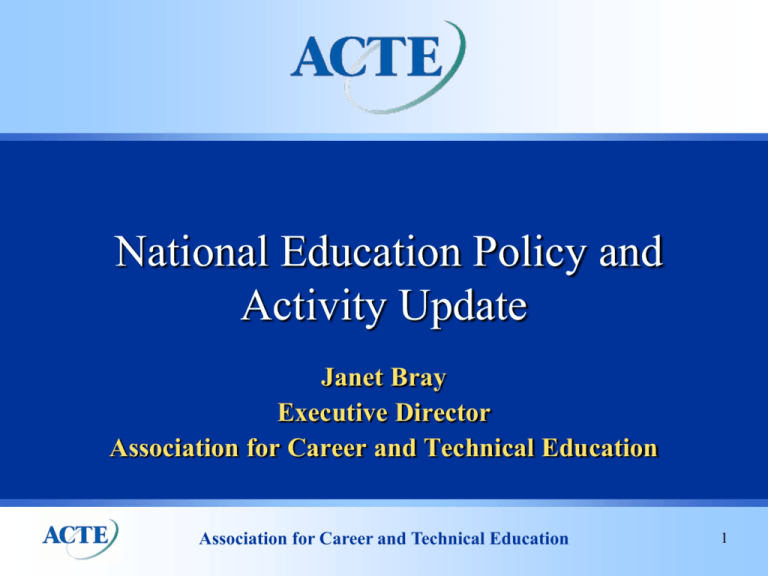
National Education Policy and Activity Update Janet Bray Executive Director Association for Career and Technical Education Association for Career and Technical Education 1 Association for Career and Technical Education 2 National Challenges • Concern about U.S. student performance, and particularly performance of minorities and disenfranchised populations -high dropout rates; -Insufficient communications, math and science skills; -high postsecondary remediation rates; and -large achievement gaps • United States global competition • Improved transitions between secondary and postsecondary education • 21st Century Skills Association for Career and Technical Education 3 Global Competition The 25% of the population in China with the highest IQ’s is greater than the total population of North America In India, it’s the top 28% In 2002, 59% of all degrees awarded in China were in engineering and physical science In the United States it was 32% China has more honors kids than we have kids Association for Career and Technical Education 4 2007 – World Economic Leaders 1. United States 2. Japan 3. England 4. Germany Source: Goldman Sacks Association for Career and Technical Education 5 2040 – World Economic Leaders 1. 2. 3. 4. China India United States Mexico 5. Russia 6. Brazil 7. Germany 8. England Source: Goldman Sacks Association for Career and Technical Education 6 Emerging Labor Market The top 10 in-demand jobs predicted for 2010 didn’t exist in 2004 90% of the fastest-growing jobs will require an education beyond high school 49 of 50 highest paying occupations require a college degree or higher Over the past 10 years, jobs requiring science and engineering skills increased 51% Association for Career and Technical Education 7 U.S. Workforce Challenges In a survey of US manufacturers, 90% of employers reported moderate to severe shortages of skilled workers Over 300,000 skilled IT jobs have gone unfilled over the last decade because of no qualified applicants 52% of teens have little or no interest in manufacturing career – 21% ambivalent Association for Career and Technical Education 8 U.S. Demographics Between 2010 and 2025, up to 95 million Baby Boomers will leave the U.S. workforce or change work focus Only 40 million Gen X’ers and Y’ers will be available to replace them Association for Career and Technical Education 9 Workforce Readiness Over 400 employers surveyed rated the workforce readiness of new workforce entrants as deficient – 42% of high school grad & GED – 11% of two-yr college grads – 9% of four-yr college grads Association for Career and Technical Education 10 U.S. Education Challenge The U.S. high school graduation rate is 17th internationally – with a 73% graduation rate One third of all high school students don’t graduate on time The U.S. college graduation rate is 14th internationally – with a 66% graduation rate Among people 18-24, the U.S. ranks 5th internationally in college enrollment with 35% of people attending college Association for Career and Technical Education 11 U.S. Education Challenge In urban school districts 50-60% of students drop out of high school Up to 55% of college freshmen must enroll in remedial courses in reading, writing and mathematics One in four freshman at 4-year colleges fail to return to school for a sophomore year One in two freshman in community colleges fail to return Association for Career and Technical Education 12 The Internet has created the greatest generation gap since the advent of rock and roll. This Generation 93% US teens 12-17 used Internet in 2006 64% created content on Internet – up from 57% in 2004 Social networking sites Students disengaged Association for Career and Technical Education 14 This Generation… Teenagers surveyed… Use MySpace and Facebook Use texting instead of e-mail (parents) Nearly 60% would rather use e-mail than a telephone Are likely to have 6 applications running at once on their PC Association for Career and Technical Education 15 This Generation… The “killer application” for today’s students isn’t You Tube, Facebook, MySpace, Google, Moodle, Pod-casting or some Wiki-site For digital teens, the one and only “killer app” is… speed Consider this … Association for Career and Technical Education 16 This Generation… The fastest growing segment of computer-users today in the U.S. is 5 to 7 year olds Association for Career and Technical Education 17 This Generation Students will expect information to be delivered through electronic media – instant messaging Technology will challenge the applied classroom - learning to occur beyond the traditional classroom environment Association for Career and Technical Education 18 Political Environment Economy taking center stage in every discussion Calls for bi-partisanship, but in many ways more partisan than ever Short Congressional Calendar Only scheduled to be in session 114 days Election year Association for Career and Technical Education 19 Obama Administration Highest proportion of college graduates by 2020 All Americans enroll in at least one year of higher education or job training Programs of Study - alignment of secondary/postsecondary Association for Career and Technical Education 20 American Reinvestment and Recovery Act $787.2 billion enacted 2/17/09 Approximately 35% tax cuts and 65% spending 74.2% of spending and tax breaks would go out by the end of FY 2010 Was expected to create/save 3-4 million jobs Major focuses on energy, science and technology, infrastructure, healthcare, and education Association for Career and Technical Education 21 ARRA Education Implementation Principles Spend funds quickly to save and create jobs Improve student achievement through school improvement and reform Ensure transparency and accountability and report publicly on the use of funds Invest one-time ARRA funds thoughtfully to minimize the “funding cliff” Association for Career and Technical Education 22 ED Four Priorities Adopting internationally benchmarked standards and assessments that prepare students for success in college and the workplace Recruiting, developing, rewarding and retaining effective teachers and principals Building data systems that measure student success and inform teachers and principals how they can improve their practices Turning around the lowest-performing schools Association for Career and Technical Education 23 ED Race to the Top timeline July 24 – announcement made Aug 28 – comments due in response to draft criteria (CTE and NASDCTEc submitted joint comments) Fall 2009 – applications accepted January 2010 – 1st round applications due April 2010 – 1st round of awards made June 2010 – 2nd round of applications due Sept 2010 – 2nd round of awards made Association for Career and Technical Education 24 Department of Labor Total funding of $3.95 billion including: – $500 million - adult employment and training activities – $1.2 billion - youth activities, including summer employment programs for youth – $1.25 - dislocated worker employment and training activities Association for Career and Technical Education 25 Department of Labor – $200 million - dislocated workers assistance national reserve – $50 million - YouthBuild activities – $750 million - competitive grants for worker training and placement in high growth and emerging industry sectors • $500 million set aside for training in careers in energy efficiency and renewable energy • Priority for remaining funds is health care sector Association for Career and Technical Education 26 Elementary and Secondary Education Act (NCLB) Largest federal elementary/secondary bill Originally due to be reauthorized in 2007 Work stalled in the 110th Congress New regulations issued from U.S. Education Department in late 2008 Secretary Duncan has called for action and Congress likely to respond but upcoming elections likely to stall progress Association for Career and Technical Education 27 FY 2011 Budget Outlook One word: Grim Increases in education funding will be very difficult Budget experts believe that Congress needs to adopt a timeline to balance the budget through both revenue increases and spending reductions Debt may continue to grow Association for Career and Technical Education 28 FY 2010 Appropriations FY 2010 Labor, Health and Human Services and Education bills signed into law in December, 2009 Total Labor, Health and Human Services and Education Appropriations increased by $8.5 billion over FY 2009 Carl D. Perkins Career and Technical Education Act funded at FY 2009 levels- $1.3 billion Association for Career and Technical Education 29 FY 2010 Appropriations New initiatives were proposed in the Department of Education and the Department of Labor that could benefit CTE – $40 million for Green Jobs Innovation Fund – $45 million for a transitional jobs program – $50 million for High School Graduation Initiative Association for Career and Technical Education 30 FY 2011 President’s Budget President Obama released his proposed budget on Monday, February 1, 2010 Carl D. Perkins Career and Technical Act was funded at FY 2010 levels - $1.3 billion The president proposes to consolidate Tech Prep with Basic State Grants. Association for Career and Technical Education 31 FY 2011 President’s BudgetDept. of Education Allocations Programs in the Department of Education saw increases and changes – 38 programs were proposed for consolidation and six programs were eliminated – ESEA received a $3 billion increase, including an expansion of Race to the Top – Additional $1 billion for ESEA would be available by a budget amendment if Congress reauthorizes ESEA Association for Career and Technical Education 32 FY 2011 President’s BudgetDept. of Education Allocations Maximum Pell Grant award proposed at $5,710 for low-income students $10.6 billion proposed for pending Student Aid and Fiscal Responsibility Act (SAFRA) $3.5 billion over five years proposed for the College Access and Completion Fund Association for Career and Technical Education 33 FY 2011 President’s BudgetDept. of Education Allocations Additional Programs in the Department of Education budget that could have an impact on CTE: – 500 million to continue the Investing in Innovation program – $25 million for a new STEM initiative in the Fund for the Improvement of Postsecondary Education – Consolidated College Pathways and Accelerated Learning program (not new funding; composed of existing programs) – $612.3 million for Adult Basic and Literacy Education State Grants – $2.3 million for the Women’s Educational Equity program to recruit women and girls to STEM – $30 million for the Workforce Innovation Fund Association for Career and Technical Education 34 FY 2011 President’s Budget In the Department of Labor theme is “Good Jobs for Everyone” – $14 billion in discretionary spending, down from $14.3 in FY 2010 – $10.9 billion for the Employment and Training Administration Association for Career and Technical Education 35 FY 2011 President’s BudgetDept. of Labor Allocations Programs that benefit CTE highlights: – $85 million for Green Jobs Innovation Fund – $40 million for transitional jobs – $13.75 million for the department's data quality initiative – Funding for the Career Pathways Innovation Fund (formerly Community-based Job Training Grants) are eliminated and funds are moved to the American Graduation Initiative in the SAFRA legislation Association for Career and Technical Education 36 Jobs for Main Street Act of 2010 House passed Jobs for Main Street Act of 2010 (H.R. 2847) on December 16 This $154 billion legislation is crafted to create jobs and address the needs of the unemployed Association for Career and Technical Education 37 Jobs for Main Street Act of 2010 Highlights of the House bill that could impact CTE: – $4.1 billion for school renovation grants – $500 million for summer youth employment in the Workforce Investment Act – $300 million for college work study – $750 million for job training in “high growth fields”; specifically green and health care industries – $23 billion for an education jobs fund—this money will be funneled through the American Recovery and Reinvestment Act’s State Fiscal Stabilization Fund to help states save and create 250,000 new education jobs over two years Association for Career and Technical Education 38 Jobs on Main Street Act of 2010Speculation President encouraged Senate to pass similar legislation to the House in his State of the Union Address Senate will have to break the legislation into pieces due to lack of bi-partisan support and will focus on: – Tax credits for businesses to hire new employees – Unemployment benefits – Investing in America’s infrastructure, including highway and school construction – Providing aid to states to hire and retain teachers, firefighters, and police officers Association for Career and Technical Education 39 Workforce Investment Act (WIA) Over 10 years since the bill was reauthorized Bill died in 109th Congress and little action in the 110th Congress Senate held listening sessions in late 2008 and spring 2009 House held hearings last year Momentum has stalled (at least for the time being) Association for Career and Technical Education 40 Administration WIA Priorities Goals for WIA Reauthorization: – – – – – Streamlining service delivery One-stop shopping for high-quality services Engaging with employers on a regional and/or sectoral basis Improving accountability Promoting innovation and identifying and replicating best practices. – Funding will increase for WIA’s Adult, Youth and Dislocated Worker grants, however, will be set aside for “Workforce Innovation Fund” grants. Association for Career and Technical Education 41 Energy Sustainability Priorities Develop and fund programs which address need for high-wage, high demand careers Train educators about new sustainable/“green” technologies Modernize and upgrade CTE facilities and equipment Support infusion of energy sustainability concepts throughout curriculum Association for Career and Technical Education 42 GREEN Act H.R. 1775 introduced March 30 Sponsored by Rep. Jerry McNerney Grants to develop CTE programs of study and facilities in areas of renewable energy Two components: – Curriculum grants to partnerships – Facilities grants Curriculum portions included in broader energy legislation passed by House Association for Career and Technical Education 43 Student Aid and Fiscal Responsibility Act (SAFRA) Supports community colleges, technical colleges and CTE via American Graduation Initiative Funds secondary and postsecondary educational facilities Changes federal student loans to Direct Loan program in 2010 to pay for new programs House passed H.R.3221 on 09/17/09 on a 253-171 vote Senate bill pending Reconciliation process and health care a factor Association for Career and Technical Education 44 Action Needed Link CTE to critical issues: – Dropout prevention and school improvement – Economic recovery – Postsecondary access and completion Highlight data and stories that exemplify CTE relevancy Use ACTE Issue Briefs & research Stay informed, build relationships and be ready to act! Association for Career and Technical Education 45 ACTE Resources Institute for 21st Century Leadership Issue Briefs/Position Papers CTE Policy Watch Blog Research Clearinghouse Web page Action Alerts State Profiles National Policy Seminar Association for Career and Technical Education 46 Association for Career and Technical Education 1410 King Street Alexandria, VA 22314 (800) 826-9972 Web: www.acteonline.org jbray@acteonline.org Association for Career and Technical Education 47
